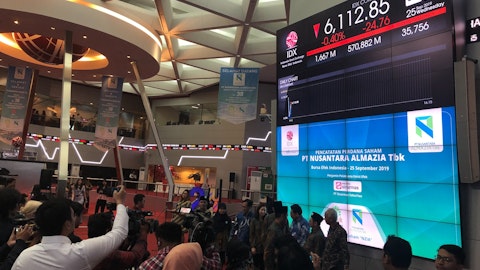Sanmina Corporation (NASDAQ:SANM) Q1 2024 Earnings Call Transcript January 29, 2024
Sanmina Corporation beats earnings expectations. Reported EPS is $1.3, expectations were $1.21. SANM isn’t one of the 30 most popular stocks among hedge funds at the end of the third quarter (see the details here).
Operator: Good afternoon, ladies and gentlemen, and welcome to the Sanmina’s First Quarter Fiscal 2024 Earnings Conference Call. At this time, all lines are in a listen-only mode. Following the presentation, we will conduct a question-and-answer session. [Operator Instructions] This call is being recorded on Monday, the 29th of January, 2024. I would now like to turn the conference over to Paige Melching, Senior Vice President of Investor Communications. Please go ahead.
Paige Melching: Thank you, Jon. Good afternoon, ladies and gentlemen, and welcome to Sanmina’s first quarter fiscal 2024 earnings call. A copy of our press release and slides for today’s discussion are available on our website at sanmina.com in the Investor Relations section. Joining me on today’s call is Jure Sola, Chairman and Chief Executive Officer.
Jure Sola: Good afternoon.
Paige Melching: And Jon Faust, Executive Vice President and Chief Financial Officer.
Jon Faust: Good afternoon.
Paige Melching: Before I turn the call over to Jure, let me remind everyone that today’s call is being webcasted and recorded and will be available on our website. You can follow along with our prepared remarks and the slides provided on our website. Please turn to Slide 3 of our presentation and take note of our safe harbor statement. During this conference call, we may make projections or other forward-looking statements regarding future events or the future financial performance of the company. We caution you that such statements are just projections. The company’s actual results could differ materially from those projected in these statements as a result of factors set forth in the safe harbor statement. The company is under no obligation to and expressly disclaims any such obligation to update or alter any of the forward-looking statements made in the earnings release, the earnings presentation, the conference call, or the investor relations section of our website, whether as a result of new information, future events or otherwise, unless otherwise required by law.
Included in our press release and slides issued today, we have provided you with statements of operation for the first quarter ended December 30, 2023 on a GAAP basis, as well as certain non-GAAP financial information. A reconciliation between the GAAP and non-GAAP financial information is also provided in the press release and slides posted on our website. In general, non-GAAP information excludes restructuring costs, acquisition and integration costs, non-cash stock-based compensation expense, amortization expense, and other unusual or infrequent items. Any comments we make on this call as it relates to the income statement measures will be directed at our non-GAAP financial results. Accordingly, unless otherwise stated in this conference call, when we refer to gross profit, gross margin, operating income, operating margin, taxes, EBITDA, net income and earnings per share, we are referring to our non-GAAP information.
I would now like to turn the call over to Jure.
Jure Sola: Thanks, Paige. Good afternoon, ladies and gentlemen, and welcome. And thank you all for being here with us today. First, I would like to take this opportunity to recognize Sanmina leadership team and our employees for doing a great job. So to you, Sanmina’s team, thank you, for your dedication and delivering excellent customer service. And let’s keep it up. Please turn to Slide 4. And now, ladies and gentlemen, I would like to introduce to you Jon Faust, Sanmina CFO. Jon joined Sanmina on December 18, 2023. He brings over 20 years of finance, accounting controls, and operational experience. Jon previously served as a Global Controller and Head of Finance, Transformation and Corporate Services at HP Inc. He was also CFO of Aruba, a Hewlett Packard enterprise company.
And he held various leadership roles at Hewlett Packard Enterprises. Jon has proven track record driving transformational business strategies. He’s a highly accomplished leader with extensive background and I can tell you I’m very happy to have Jon on Sanmina leadership team. Now let’s go to our agenda for today’s call. You have Jon to review details of our results for you. I will follow up with additional comments about Sanmina results and our future goals. Then, Jon and I will open for questions and answers. And now I’d like to turn this call over to Jon. Jon?
Jon Faust: Great. Thank you, Jure. Good afternoon, ladies and gentlemen. It’s a pleasure to be here today and to be on my first earnings call for Sanmina. I’ve been with the company for about six weeks now, and I’ve really enjoyed meeting the team and learning about the business. Sanmina is a company that I have long respected during my many years at HP because of its customer centric approach, focus on operational excellence, and overall reputation of being a market leader in the EMS industry. While I’ve only been here for a short time, my experience to date has only strengthened that perspective. I’m excited to be here and to work with Jure and the rest of the leadership team to continue to deliver on Sanmina’s strategy and to drive value for our shareholders.
With that, let’s talk about the Q1 results. Please turn to Slide 6. First, I want to commend the entire Sanmina team for executing well and delivering financial results in line with the company’s outlook while continuing to navigate the difficult period in the market. First quarter revenue was $1.87 billion, in line with our outlook of $1.85 billion to $1.95 billion. As a reminder, the decline in revenue results from the ongoing market-driven inventory absorption that we’ve been managing with our customers, which is unfolding in line with our expectations. Non-GAAP gross margin was 8.8%, up 10 basis points sequentially, and 30 basis points compared to the same period last year, which was at the high end of our outlook, largely driven by a favorable mix.
Non-GAAP operating margin was 5.5%, down 20 basis points sequentially and 50 basis points compared to the same period last year, which is at the midpoint of our outlook, as we continue to carefully manage costs and make targeted investments when needed. Non-GAAP earnings per share came in at $1.30, based on 58 million shares outstanding on a fully diluted basis and at the high end of our outlook. Please turn to Slide 7 where I’ll talk about the segment results. IMS revenue came in at $1.5 billion, down approximately 8% sequentially due to lower demand and ongoing customer inventory adjustments, with non-GAAP gross margin down 40 basis points to 7.6%, due to lower revenue and mix. CPS revenue came in at $394 million, down 10% sequentially, due to similar dynamics as the IMS segment, but non-GAAP gross margin was solid at 13% due to favorable mix and operational improvements we’ve been driving across the business.

Now please turn to Slide 8, where I’ll comment on the balance sheet. Sanmina has a very strong balance sheet, which is a key advantage of the company and a pillar of our value proposition to investors. Cash and cash equivalents were $632 million. We ended the first quarter with inventory of $1.4 billion, which is down 6% sequentially and down 18% from a year ago, as we have continued to focus on improving our inventory position. We continue to have one of the strongest balance sheets in the industry with low leverage, which allows us to both navigate complex market environments and capitalize on the long-term opportunity in front of us. Please turn to Slide 9, where I’ll talk about cash flow and capital allocation. We did a great job managing cash this quarter, and as I’ve been reviewing Sanmina’s capital allocation priorities, I’m confident we’re putting our cash to use in the right areas.
Each quarter, we evaluate our capital allocation requirements and look for opportunities to drive shareholder value, taking a disciplined ROI-based approach when making decisions. As a reminder, those priorities are to, number one, fund organic growth, number two, execute on strategic transactions, number three, reduce our debt and carefully manage our leverage ratio, and number four, do share repurchases, the actual mix of which depends on our needs and opportunities. To touch on a few highlights, cash flow from operations for the quarter was $126 million. Capital expenditures were $34 million as we continued to make investments in the end markets that will support Sanmina’s long-term profitable growth. Free cash flow was $92 million. And during the quarter, we repurchased 2.1 million shares for approximately $106 million.
And as of December 30, we have approximately $174 million left on our Board authorized plan. Going forward, we will look to do share repurchases opportunistically. To conclude on the Q1 actual results, overall, it was a strong quarter, as we delivered on what we said we would, despite the headwinds we face, as customers continue to adjust inventory levels. Please turn to Slide 10. I’ll now cover our outlook for the second quarter, which is based on everything we are seeing in the market and forecasts from our customers. Our outlook is as follows. Revenue between $1.825 billion to $1.925 billion, essentially flat with the prior quarter. Now, while we’re not providing guidance beyond the second quarter, we are seeing signs that demand and revenue should start to improve in the second half of the year, which Jure will elaborate on shortly.
Non-GAAP gross margin of 8.3% to 8.8%, consistent with prior quarters and dependent on mix. Operating expenses of $60 million to $62 million, in line with normal levels. Non-GAAP operating margin of 5.2% to 5.6%. Other income and expense, approximately $12 million, in line with normal levels. A tax rate of 17% to 18%. We also estimate an approximate $3.0 to $3.5 million non-cash reduction to our net income to reflect our JV partners equity interests. Non-GAAP EPS in the range of $1.20 to $1.30 based on approximately 57 million fully-diluted shares outstanding. Capital expenditures to be around $40 million to support new programs and future opportunities as we continue to invest where needed to support our long-term strategy. And finally, depreciation of approximately $30 million.
Overall, I’m very pleased with our performance this quarter and excited about the opportunity ahead. And now that I’m on board, I look forward to meeting with many of you and hearing your perspectives. With that, let me turn it back to Jure.
Jure Sola: Thank you, Jon. Ladies and gentlemen, let me add a few more comments about our financial highlights for the first quarter and I’ll review our end markets and outlook for the second quarter and the rest of the fiscal year ‘24. Please turn to Slide 12. For the first quarter, as you already heard, overall we met outlook and we demonstrated our ability to manage costs and operational execution in this macroeconomic environment. For overall markets, we are seeing ongoing customer inventory adjustment coupled with softer demand across the industry. What is Sanmina advantage in this environment? Our business is aligned to adapt to market dynamics like this. We have strong cost management and operational execution. We are well diversified in growth markets.
In the key markets that we focus on, our customers require Sanmina technical capabilities, global regional footprint, and industry-leading IT systems managed by Sanmina Smart Connected MES. The bottom line is that Sanmina provides a competitive advantage to our customers by delivering predictable and consistent performance globally. Please turn to Slide 13. Let me talk to you now about the revenue by end markets. As we said, we are operating in a very dynamic environment. Our team did a great job delivering first quarter financial results in a line with our outlook. As you can see in a graph, industrial, medical, defense and automotive was 67% of our revenue, came in at $1.257 billion for quarter. Quarter to quarter revenue was down 6.4%. What we saw in here is some inventory adjustments and softer demand — softness in the medical sector.
For communication, networks, and cloud infrastructure, we delivered 33% of revenue or $618 million. Quarter-over-quarter was down 12.8%, mainly due to inventory adjustment at communications, market, and softer demand from end markets. We also saw some softness in cloud enterprise sector. For the first quarter, top 10 customers represented 45% of our revenue. Bookings for the first quarter were slightly better than the fourth quarter of 2023. Demand for the second quarter is sequentially flat, but we expect to see sequential improvements in second half of fiscal year ‘24. Please turn to Slide 14. Now let’s talk about the markets that’s going to drive the future growth for us. Sanmina has been investing in faster growing and higher margin end markets.
These are key markets for us. Cloud, defense and aerospace, medical digital health, electrical vehicles, renewable energy, industrial and optical packaging. For cloud, basically build around AI and ML, we see a lot more new opportunities driven by upgrade of cloud networks to meet AI traffic needs for the future. Defense and aerospace will continue to see solid demand. For medical digital health, we have strong base of customers with positive trends for longer term. For electrical vehicles and electrical vehicle charges, we see a fair amount of new projects and lots of great opportunities in front of us. Renewable energy, new projects for us will drive the growth. For industrial, we have a solid base of a business and new projects in a pipeline.
And optical packaging, for us it’s all about 800 gigs. We see a lot of trends in this side of the business. So I can tell you that the pipeline of the new opportunity is exciting for our future. Please turn to Slide 15. Now let me tell you about Sanmina’s priorities to drive long-term profitable growth. Number one, Sanmina culture is basically to build everything around customer requirements. We are a very customer-centric company. Because of that, we’re able to build a strong long-term partnership with the market leaders. We have great diversified customer base in key markets, and strategy, again, is to build around the customer needs. And I can tell you that we are, even in this market, we are adding new strategic customers to our existing base.
Number two is to continue to provide leading technology in heavy regulated markets. Our technology is a competitive advantage. We provide total solutions from NPI to full systems. We are well respected by our customers and industry for quality of execution. We also deliver time to market flexibility for our customers, so they can get their new products to the market at a faster rate. Number three, Sanmina is positioned for a long-term growth. For fiscal year ‘24, we’re starting with a lower revenue base. We knew that beginning of the year, with all the inventory correction that is going on. But we do have a strong pipeline of the new opportunities. We do expect sequential improvements in the second half of fiscal year ‘24, and we’ll continue to invest in the growth opportunities.
We also continue to optimize capital structure to drive the growth in next two to three years. So this way I can tell you that the revenue goal is to get back to $9 billion run rate and then drive that growth to $10 billion to $12 billion. But we don’t want to just grow. Number four for us is margin expansion and cash flow generation. We are focused on margin expansion. And our business model will allow us to do that. Short term, our operating margin goal is 5% to 6%. And if you look at the last two years, we’re able to deliver those numbers more than a high end. Longer term, we believe that our long term operating margin goal internally is over 6-plus-percent. We have high confidence we’ll get there. And we’ll continue to generate cash to drive this growth.
And number five for us is how do we maximize the shareholder value short-term and long-term? As Jon told you earlier, we repurchase shares opportunistically. For the first quarter, we bought over $100 million. And what’s also positive in Sanmina business here is that we have significant leverage still in our business model. So now please turn to Slide 16. For the first quarter, as you already heard from us, we had a solid execution and excellent performance by our team. Revenue of $1.87 billion, in line with our outlook. We delivered a non-GAAP operating margin of 5.5% and we delivered non-GAAP diluted EPS of $1.30 and this is at the high end of our outlook. For second quarter revenue outlook, we’re going to be at $1.825 billion to $1.925 billion.
And non-GAAP diluted EPS, we’re guiding between $1.20 to $1.30, which is basically flat to our first quarter. For the year, as we already said, we are seeing ongoing customer inventory absorption and softness in demand for the first half of this year. But we believe for the second half of the year, we expect to see sequential improvements. Ladies and gentlemen, now I would like to thank you for all of your time and support. Operator, we are now ready to open the lines for question and answers. Thank you all again.
See also 10 Best Performing Growth Stocks in January 2024 and Top 20 Largest Seafood Companies in the World.
Q&A Session
Follow Sanmina Corp (NASDAQ:SANM)
Follow Sanmina Corp (NASDAQ:SANM)
Operator: Thank you. Ladies and gentlemen, we will now begin the question-and-answer session. [Operator Instructions] Your first question comes from the line of Christian Schwab from Craig-Hallum Capital Group. Your line is now open.
Jure Sola: Hello, Christian.
Christian Schwab: Hey, Jure. Can you just Specifically, on the growth markets, can you tell us which one or two that you guys anticipate driving the sequential growth in the back half of the year?
Jure Sola: Well, as I mentioned earlier, if you look at our industrial, medical, defense and aerospace markets, we believe those markets are pretty stable for us. Yeah, there’s some inventory adjustments going on now, but we expect to see nice improvements in third, especially as we exit our fiscal year and then first quarter of calendar year and next year. So those are the markets. Also when it comes to, let’s talk about communication network for us, if you look at that market, we had a major inventory correction with some of the projects there. Based on those, we see some improvements in the second half, and some improvements will probably take longer than a couple quarters to get there. But on the cloud infrastructure side, a lot of our networking customers are into cloud AI, and we are involved in a lot of the new projects that are coming up that basically will be upgrading the cloud infrastructure, and we believe that Sanmina will have a fair amount to participate in that segment in the second half of the year and beyond.
Christian Schwab: So on the communications equipment part, do you anticipate that exiting this quarter, for the most part, each customer’s inventory levels vary, but do you think after this quarter, the worst is kind of behind you, or is there just going to be puts and takes that some have, as you suggested, a few more multiple quarters of digestion and others are possibly returning to ordering again? [I guess that was clear] (ph).
Jure Sola: Yeah, I would expect to see improvements in the third quarter of our fiscal year, even across those markets, but to see more, better improvements probably until the fourth quarter on some of that. But I would say worst is behind us. We’ll see how we go through this quarter, but I would, I don’t know if I’m smart enough to know when is the bottom, but I would expect, I do expect based on what I see and what I’m hearing from key customers, that definitely third quarter we should be able to improve our shipments. So I can say that, yeah, I think the worst is behind us. Because some of these communication corrections been going on for the last 2.5 quarters.
Christian Schwab: Right, correct, yeah. So then my last question, Jure, on the optical, you talked about seeing strength, in particular, at 800 gig. Are you guys seeing any strength or well positioned as the industry possibly starts moving to 1.2 terabytes?
Jure Sola: Yes. Yeah. We are working on some of those new programs, yes, especially the [pluggable] (ph) side of the business.
Christian Schwab: Okay. And you would anticipate that that market would be solid in ‘24? Is that fair?
Jure Sola: For us, I think, definitely there’s some positive movements around, but I would say end of the ‘24 ,‘25, we expect a fair amount of upside in that segment.
Christian Schwab: Okay, great. Thanks, Jure. No other questions.
Jure Sola: Thanks, Christian.
Operator: Your next question comes from the line of Anja Soderstrom from Sidoti. Your line is now open.
Anja Soderstrom: Hi, thank you for taking my questions. Congratulations on the following quarter here, despite the challenging environment.
Jure Sola: Thanks, Anja.
Anja Soderstrom: I also want to dive a little bit further into the end markets as well and the medical there. We heard from other peers there that there has been some inventory corrections there. What are you hearing in terms of that and do you have new progress that are ramping that will sort of offset that if that’s prolonged longer than anticipated?
Jure Sola: Yeah, Anya, there’s an inventory correction now across almost every customer out there, but at a different level, okay? There’s some that’s not a major impact, and like in communication side, we had a more impact. On a medical side, during this quarter that we just finished, we had some softness in demand and some inventory correction and we expect that to continue in the second quarter and we hope that improvement in the third and fourth quarter of this year. So our base of — around 20% of our revenue comes from medical, so it’s a very solid customer base for us. But with us, we also have a lot of programs that are basically changing into the 20 — end of ‘24 and ‘25, in some cases even to ‘26. So in the next two years we’ve got a lot of new programs they have upside but also going through some upgrades.
Anja Soderstrom: Okay, and was there any — any of these end markets within those groups that you’re talking about that were particularly strong?
Jure Sola: Definitely, defense and aerospace for us is still a solid demand. We’re still chasing certain parts, especially in some of the unique technology. Renewable energy for us is — demand is strong, is now, but a lot of these are new programs, so just ramping up the new programs. Industrial for us was solid. That was about 27% of our revenue. So that’s — that continued to be solid for us. And like I said earlier in prepared statement, on cloud, we’re starting to see fair amount of demand from our customers as they are switching to support AI and ML.



